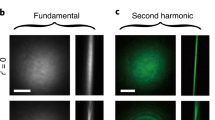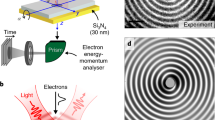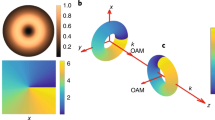Abstract
Optical interactions are governed by both spin and angular momentum conservation laws, which serve as a tool for controlling light–matter interactions or elucidating electron dynamics and structure of complex systems. Here, we uncover a form of simultaneous spin and orbital angular momentum conservation and show, theoretically and experimentally, that this phenomenon allows for unprecedented control over the divergence and polarization of extreme-ultraviolet vortex beams. High harmonics with spin and orbital angular momenta are produced, opening a novel regime of angular momentum conservation that allows for manipulation of the polarization of attosecond pulses—from linear to circular—and for the generation of circularly polarized vortices with tailored orbital angular momentum, including harmonic vortices with the same topological charge as the driving laser beam. Our work paves the way to ultrafast studies of chiral systems using high-harmonic beams with designer spin and orbital angular momentum.
This is a preview of subscription content, access via your institution
Access options
Access Nature and 54 other Nature Portfolio journals
Get Nature+, our best-value online-access subscription
$29.99 / 30 days
cancel any time
Subscribe to this journal
Receive 12 print issues and online access
$209.00 per year
only $17.42 per issue
Buy this article
- Purchase on Springer Link
- Instant access to full article PDF
Prices may be subject to local taxes which are calculated during checkout





Similar content being viewed by others
Data availability
The datasets and analysis routines utilized to prepare the data presented in this manuscript are available, free of charge, from the corresponding authors under reasonable request.
References
Beth, R. A. Mechanical detection and measurement of the angular momentum of light. Phys. Rev. 50, 115–125 (1936).
Allen, L., Beijersbergen, M. W., Spreeuw, R. J. C. & Woerdman, J. P. Orbital angular momentum of light the transformation of Laguerre-Gaussian laser modes. Phys. Rev. A 45, 8185–8189 (1992).
Yao, A. M. & Padgett, M. J. Orbital angular momentum: origins, behavior and applications. Adv. Opt. Photon. 3, 161–204 (2011).
Calvo, G. et al. Measuring the complete transverse spatial mode spectrum of a wave field. Phys. Rev. Lett. 100, 173902 (2008).
Ballantine, K. E., Donegan, J. F. & Eastham, P. R. There are many ways to spin a photon: half-quantization of a total optical angular momentum. Sci. Adv. 2, e1501748 (2016).
Cardano, F. & Marrucci, L. Spin-orbit photonics. Nat. Photon. 9, 776–778 (2015).
Willner, A. E. et al. Optical communication using orbital angular momentum beams. Adv. Opt. Photon. 7, 66–106 (2015).
Torres, J. P. & Torner, L. Twisted Photons: Applications of Light with Orbital Angular Momentum (Wiley-VCH, Bristol, 2011).
Beaulieu, S. et al. Photoexcitation circular dichroism in chiral molecules. Nat. Phys. 14, 484–489 (2018).
Padgett, M. & Bowman, R. Tweezers with a twist. Nat. Photon. 5, 343–348 (2011).
Marrucci, L., Manzo, C. & Paparo, D. Optical spin-to-orbital angular momentum conversion in inhomogeneous anisotropic media. Phys. Rev. Lett. 96, 163905 (2006).
Eichmann, H. et al. Polarization-dependent high-order two-color mixing. Phys. Rev. A 51, R3414 (1995).
Fleischer, A., Kfir, O., Diskin, T., Sidorenko, P. & Cohen, O. Spin angular momentum and tunable polarization in high-harmonic generation. Nat. Photon. 8, 543–549 (2014).
Ferré, A. et al. A table-top ultraviolet light source in the extreme ultraviolet for circular dichroism experiments. Nat. Photon. 9, 93–98 (2015).
Hickstein, D. D. et al. Non-collinear generation of angularly isolated circularly polarized high harmonics. Nat. Photon. 9, 743–750 (2015).
Lambert, G. et al. Towards enabling femtosecond helicity-dependent spectroscopy with high-harmonic sources. Nat. Commun. 6, 6167 (2015).
Ellis, J. L. et al. High harmonics with spatially varying ellipticity. Optica 5, 479–485 (2018).
Huang, P.-C. et al. Polarization control of isolated high-harmonic pulses. Nat. Photon. 12, 349–354 (2018).
Zürch, M. et al. Strong-field physics with singular light beams. Nat. Phys. 8, 743–746 (2012).
Hernández-García, C. et al. Attosecond extreme ultraviolet vortices from high-order harmonic generation. Phys. Rev. Lett. 111, 083602 (2013).
Gariepy, G. et al. Creating high-harmonic beams with controlled orbital angular momentum. Phys. Rev. Lett. 113, 153901 (2014).
Géneaux, R. et al. Synthesis and characterization of attosecond light vortices in the extreme ultraviolet. Nat. Commun. 7, 12583 (2016).
Rego, L., San Román, J., Picón, A., Plaja, L. & Hernández-García, C. Nonperturbative twist in the generation of extreme-ultraviolet vortex beams. Phys. Rev. Lett. 117, 163202 (2016).
Kong, F. et al. Controlling the orbital angular momentum of high harmonic vortices. Nat. Commun. 8, 14970 (2017).
Gauthier, D. et al. Tunable orbital angular momentum in high-harmonic generation. Nat. Commun. 8, 14971 (2017).
Turpin, A., Rego, L., Picon, L., Roman, J. S. & Hernandez-Garcia, C. Extreme ultraviolet fractional orbital angular momentum beams from high harmonic generation. Sci. Rep. 7, 43888 (2017).
Hernández-García, C. et al. Extreme ultraviolet vector beams driven by infrared lasers. Optica 4, 520–526 (2017).
Schafer, K. J., Yang, B., DiMauro, L. F. & Kulander, K. C. Above threshold ionization beyond the high harmonic cutoff. Phys. Rev. Lett. 70, 1599–1602 (1993).
Corkum, P. B. Plasma perspective on strong-field multiphoton ionization. Phys. Rev. Lett. 71, 1994–1997 (1993).
McPherson, A. et al. Studies of multiphoton production of vacuum-ultraviolet radiation in the rare gases. J. Opt. Soc. Am. B 4, 595 (1997).
Ferray, M. et al. Multiple-harmonic conversion of 1064-nm radiation in the rare gases. J. Phys. B 21, L31–L35 (1998).
Fan, T. et al. Bright circularly polarized soft X-ray high harmonics for X-ray magnetic circular dichroism. Proc. Natl Acad. Sci. USA 111, 14206–14211 (2015).
Rundquist, A. et al. Phase matching of soft X-ray harmonic emission in hollow-core fibers. Science 280, 1412–1415 (1998).
Popmintchev, T. et al. Bright coherent ultrahigh harmonics in the keV X-ray regime from mid-infrared femtosecond lasers. Science 336, 1287–1291 (2012).
Dorney, K. M. et al. Helicity-selective enhancement and polarization control of attosecond high-harmonic waveforms driven by bichromatic circularly polarized laser fields. Phys. Rev. Lett. 119, 063201 (2017).
Jiménez-Galán, Á. et al. Control of attosecond light polarization in two-color bicircular fields. Phys. Rev. A 97, 023409 (2018).
Hernández-García, C. A twist in coherent X-rays. Nat. Phys. 13, 327–329 (2017).
Hernández-García, C. et al. High-order harmonic propagation in gases within the discrete dipole approximation. Phys. Rev. A 82, 033432 (2010).
Chen, C. et al. Tomographic reconstruction of circularly polarized high-harmonic fields: 3D attosecond metrology. Sci. Adv. 2, e1501333 (2016).
Hernández-García, C. et al. Schemes for generation of isolated attosecond pulses of pure circular polarization. Phys. Rev. A 93, 043855 (2016).
Hernández-García, C., San Román, J., Plaja, L. & Picón, A. Quantum-path signatures in attosecond helical beams driven by optical vortices. New J. Phys. 17, 093029 (2015).
Alon, O. E., Averbukh, V. & Moisevev, N. Selection rules for the high harmonic generation spectra. Phys. Rev. Lett. 80, 3743–3746 (1998).
Pisanty, E., Sukiasyan, S. & Ivanov, M. Spin conservation in high-order harmonic generation using bicircular fields. Phys. Rev. A 90, 043829 (2014).
Paufler, W., Böning, B. & Fritzsche, S. Tailored orbital angular momentum in high-order harmonic generation with bicircular Laguerre-Gaussian beams. Phys. Rev. A 98, 011401(R) (2018).
Bliokh, K. Y., Rodríguez-Fortuño, F. J., Nori, F. & Zayats, A. V. Spin-orbit interactions of light. Nat. Photon. 9, 796–808 (2015).
Milošević, D. B., Becker, W. & Kopold, R. Generation of circularly polarized high-order harmonics by two-color coplanar field mixing. Phys. Rev. A 61, 063403 (2000).
Medišauskas, L., Wragg, J., van der Hart, H. & Ivanov, M. Y. Generating elliptically polarized attosecond pulses using bichromatic counterrotating circularly polarized laser fields. Phys. Rev. Lett. 115, 153001 (2015).
Milošević, D. B. Generation of elliptically polarized attosecond pulse trains. Opt. Lett. 40, 2381–2384 (2015).
Milošević, D. B. & Becker, W. Attosecond pulse trains with unusual nonlinear polarization. Phys. Rev. A 62, 011403(R) (2000).
Sanson, F. et al. Hartmann wavefront sensor characterization of a high charge vortex beam in the XUV spectral range. Opt. Lett. 43, 2780–2783 (2018).
Beaurepaire, E., Merle, J.-C., Daunois, A. & Bigot, J.-Y. Ultrafast spin dynamics in ferromagnetic nickel. Phys. Rev. Lett. 76, 4250–4253 (1996).
Boeglin, C. et al. Distinguishing the ultrafast dynamics of spin and orbital moments in solids. Nature 465, 458–461 (2010).
Chen, C. et al. Distinguishing attosecond electron–electron scattering and screening in transition metals. Proc. Natl Acad. Sci. USA 114, E5300–E5307 (2017).
Tengdin, P. et al. Critical behavior within 20 fs drives the out-of-equilibrium laser-induced magnetic phase transition in nickel. Sci. Adv. 4, 9744 (2018).
Cireasa, R. et al. Probing molecular chirality on a sub-femtosecond timescale. Nat. Phys. 11, 654–658 (2015).
Fujita, H. & Sato, M. Ultrafast generation of skyrmionics defects with vortex beams: printing laser profiles on magnets. Phys. Rev. B 95, 054421 (2017).
van Veenendaal, M. Interaction between X-ray and magnetic vortices. Phys. Rev. B 92, 245116 (2015).
Picón, A. et al. Transferring orbital and spin angular momenta of light to atoms. New J. Phys. 12, 083053 (2010).
Eckart, S. et al. Ultrafast preparation and detection of ring currents in single atoms. Nat. Phys. 14, 701–704 (2018).
van Veenendaal, M. & McNulty, I. Prediction of strong dichroism induced by X rays carrying orbital angular momentum. Phys. Rev. Lett. 98, 157401 (2007).
Acknowledgements
The authors are thankful for useful and productive conversations with E. Pisanty, C. Durfee, D. Hickstein, S. Alperin and M. Siemens. H.C.K. and M.M.M. graciously acknowledge support from the Department of Energy BES Award No. DE-FG02–99ER14982 for the experimental implementation, as well as a MURI grant from the Air Force Office of Scientific Research under Award No. FA9550–16–1–0121 for the theory. J.L.E., N.J.B. and Q.L.N. acknowledge support from National Science Foundation Graduate Research Fellowships (Grant No. DGE-1144083). C.H.-G., J.S.R. and L.P. acknowledge support from Junta de Castilla y León (SA046U16) and Ministerio de Economía y Competitividad (FIS2013–44174-P, FIS2016–75652-P). C.H.-G. acknowledges support from a 2017 Leonardo Grant for Researchers and Cultural Creators, BBVA Foundation. L.R. acknowledges support from Ministerio de Educación, Cultura y Deporte (FPU16/02591). A.P. acknowledges support from the Marie Sklodowska-Curie Grant, Agreement No. 702565. We thankfully acknowledge the computer resources at MareNostrum and the technical support provided by Barcelona Supercomputing Center (RES-AECT-2014–2–0085). This research made use of the high-performance computingresources of the Castilla y León Supercomputing Center (SCAYLE, www.scayle.es),financed by the European Regional Development Fund (ERDF). Certain commercial instruments are identified to specify the experimental study adequately. This does not imply endorsement by the National Institute of Standards and Technology (NIST) or that the instruments are the best available for the purpose.
Author information
Authors and Affiliations
Contributions
C.H.-G., K.M.D., M.M.M., H.C.K., L.R. and L.P. conceived and designed the SAM–OAM HHG experiment. K.M.D., N.J.B., C.-T.L., J.L.E. and Q.L.N. conducted the experiment. K.M.D. analysed the experimental data. C.H.-G., L.R., J.S.R., A.P. and L.P. performed the theoretical simulations and analysed the resulting data. J.M.S. prepared the EUV MCD sample. C.H.-G., L.P., M.M.M. and H.C.K. supervised the theoretical simulations and experimental work and developed the required facilities and measurement capabilities. C.H.-G., K.M.D., L.R., J.S.R., M.M.M. and L.P. wrote and prepared the manuscript, to which all authors provided constructive improvements and feedback.
Corresponding authors
Ethics declarations
Competing interests
M.M.M. and H.C.K. have a interest in KMLabs. The other authors declare no competing interests.
Additional information
Publisher’s note: Springer Nature remains neutral with regard to jurisdictional claims in published maps and institutional affiliations.
Supplementary information
Supplementary Information
This file contains Supplementary Figures 1–4 and additional information about the work.
Rights and permissions
About this article
Cite this article
Dorney, K.M., Rego, L., Brooks, N.J. et al. Controlling the polarization and vortex charge of attosecond high-harmonic beams via simultaneous spin–orbit momentum conservation. Nature Photon 13, 123–130 (2019). https://doi.org/10.1038/s41566-018-0304-3
Received:
Accepted:
Published:
Issue Date:
DOI: https://doi.org/10.1038/s41566-018-0304-3
This article is cited by
-
Topological high-harmonic spectroscopy
Communications Physics (2024)
-
Orbital angular momentum lasers
Nature Reviews Physics (2024)
-
Structured air lasing of N2+
Communications Physics (2023)
-
Enabling elliptically polarized high harmonic generation with short cross polarized laser pulses
Scientific Reports (2023)
-
Wavefront control of subcycle vortex pulses via carrier-envelope-phase tailoring
Light: Science & Applications (2023)



